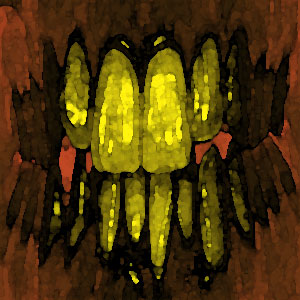Tell us about the origins of this brilliant flash.
This flash began one day last summer as I was sitting at my desk at work. A very minor earthquake hit, barely shaking the walls. My first California earthquake! I was excited. (I’m easily excited.) It felt just as I described in the story, like a big door shutting. I thought an earthquake would be an interesting new topic for me to tackle in my fiction, so I jotted down a note about it in my writing notebook. I read through that notebook a few months ago, and something about the way the short note was written made me visualize this silent couple, riding out the real earthquake and this “other” quake at the same time.
How does the idea of “quake” reverberate throughout this piece? How important is “metaphor” to what you are trying to do with your flash pieces?
I hope the idea of “quake” works in many ways throughout this very short story. I used the word “Quake” as the title (rather than Earthquake or something else) because it brings to mind not only the physical shaking of an earthquake, but also feelings of instability, fear, and cold, which represent the story’s two characters. I used the earthquake as a metaphor for the discord in their relationship: plates shift way beneath the surface, tension builds and must be (eventually) released.
The “brief and easy” contrast in some way to that “heavy door slamming shut.” What do you make of this contrast?
“Brief and easy” is not meant necessarily to contrast with “heavy door slamming shut”, but is meant more to show that as far as earthquakes go, this one (so minor, like a door slamming) is brief and easy. Earthquakes (and the earthquake moments in relationships) can be 10.0 or they can be just “door slamming shut. ” This moment, with the two characters so passively regarding one another, is “door” level on their relationship earthquake scale. In other words, it could have been much worse. But I also wanted the image of the “door slamming shut elsewhere in the house” to signify that there could be some unseen damage to their relationship (an ending that they’re not aware of yet), kind of like hidden structural damage from an earthquake.
Beth, you were the recipient of the first SLQ Kathy Fish Fellowship. How’s that going? What new and amazing things have the SLQ editors turned you onto?
The Fish Fellowship is going great. The SLQ editors have all been so supportive and helpful. They have reviewed several of my stories and made suggestions for revisions that I would have never thought of—ways to beef up here, cut there, and get to the real meat of the story. One of the things they’ve turned me on to is story rearranging—breaking up a story and shuffling its pieces around. The original idea is there, the story just unfolds in a different way. This really has helped me to find holes and to push my stories in new directions.
At the recent AWP conference, a number of writers talked about their old flames, books that have influenced them during a formative time in their lives—and ones they return to for lessons in writing and, of course, life. Discuss your old flame, both what it meant to you then and what it means to you now.
One of the first novels that I really read and reread was by Danielle Steel (aren’t most old flames at least a little bit embarrassing?). It was called Message from Nam, and was about a female journalist writing from Saigon during the Vietnam war. I went on to major in journalism as an undergrad, and took my old copy of Message from Nam with me. Years later, in graduate school, I started writing short stories. Because I didn’t really know how to do that, I read a lot of collections. Some of my favorites (Jhumpa Lahiri’s Interpreter of Maladies, Aimee Bender’s The Girl in the Flammable Skirt, Thom Jones’s The Pugilist at Rest, Stacey Richter’s My Date with Satan, Amy Hempel’s Reasons to Live) still have a place on my “Best” bookshelf. I still go back to the Lahiri and Bender collections often, AND that garage-sale copy of Message from Nam, for inspiration and lessons in storytelling.



 The SmokeLong Grand Micro Contest (The Mikey) is now an annual competition celebrating and compensating the best micro fiction and nonfiction online.
The SmokeLong Grand Micro Contest (The Mikey) is now an annual competition celebrating and compensating the best micro fiction and nonfiction online.